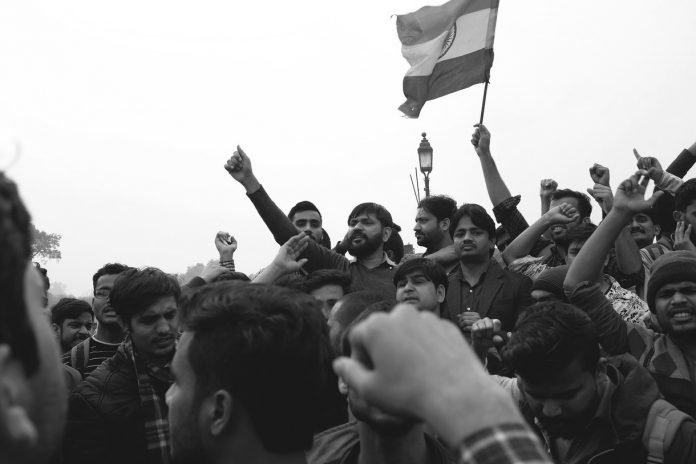Introduction –
When a group, community or even a person goes up to protest, it is usually to showcase their disapproval or demur against any action, policy, statement, etc of state or government or any organisation. Majorly the purpose of the protest is against the group who is in power from collective Organisationof people to inform the state and central about the demands and difficulties . Generally the protest work in different ways, firstly, it helps a particular community or group or person to show their disagreement with the policy in question and secondly, it helps the government to identify the loopholes in their policy or action and work towards its betterment.
History of the fights in the pre-freedom time frame-
Fights in India has a long and prominent history. Until 72 years prior, India was a settlement administered by Britishers.
In the post-autonomy time, as a result of political dissidents ,the residents of India were liberated from the rulers.
Mohandas Karamchand Gandhi also known as Mahatma Gandhi, who is otherwise called the dad of the Indian country showed the Indians residents, the force of tranquil dissent.
Thus, the developments who had molded the historical backdrop of the country that was the tranquil dissent contrary to the frontier rule were the Swadeshi Movement of 1905 or Satyagraha in 1930.
To show disagree towards British colonization and to address and against the public authority, Indians contended energetically every fight to openly communicate their perspectives on pioneer approaches.
It is the obligation that one should cling to their obligations or duties in a vote based country,while practicing or appreciating the right to quiet dissent.
Political dissent is an activity or a progression of activities by a gathering of individuals who try to: 1) express their dissatisfaction with regards to current conditions,
2) Address shameful acts in the political framework, and
3) Advocate for changes in government or business approaches.
There are principally two sorts of political fights. –
Peaceful fights include utilizing quiet strategies to achieve political change like petitions, strikes, blacklists, mobilizes, and walks.
Fierce fights include utilizing forceful strategies to attempt to achieve political change like demonstrations of psychological warfare, annihilation of property, real damage, and mobs.
The Indian freedom pioneer Mohandas (Mahatma) Gandhi was one of history’s most acclaimed advocates of peaceful dissent and obstruction, what is broadly known as Civil Disobedience (Civil Disobedience Defined, Stanford Encyclopedia of Philosophy). Gandhi accepted savagery was an ungainly weapon that made undeniably a larger number of issues than it tackled. Gandhi held that by declining to revolt viciously against British abuse, local Indians would uncover the settlers as the genuine savages who were pursuing fighting against a serene and blameless local area.
A understudy of the Constitution may inspect it and track down that the word ‘fight’ is absent. He may peruse the important articles of the Constitution, especially Article 19, by and large non-strategically. For instance, the right to free discourse and articulation might be interpreted as meaning that everybody has a privilege to state their own viewpoint on, say, a film, or on the state of the city they possess; the option to partner to mean the option to shape automatic clubs, proficient affiliations or social orders; and the right of tranquil gathering to mean the option to have a cookout in a recreation center or to take part in a strict celebration like the KumbhMela. Significant as these rights are — in dictator, close-minded states, even these rights are not ensured — this view is too tight on the grounds that in a majority rules system every one of these typifies dynamic not inactive citizenship. They establish our political opportunities. The right to free discourse and articulation changes into the option to uninhibitedly state viewpoint on the lead of the public authority. The right to affiliation turns into the option to relate for political purposes — for example, to on the whole test government choices and to try and point, calmly and lawfully, to uproot the public authority, to not simply check maltreatment of force yet to wrest power. This is the premise of our multiparty framework where Opposition parties are significant foes, not adversaries, and contend soundly for political force. At last, the option to serenely collect permits ideological groups and citizenship bodies, for example, college based understudy gatherings to address and have a problem with demonstrations of the public authority by exhibitions, tumults and public gatherings, to dispatch supported dissent developments. So, every one of these rights has two understandings. On the first, these are practiced to a great extent by individuals for private purposes, liberated from government impedance, in a traditionally liberal, non-political public space. On the second, rights are emphatically associational, practiced to impact or acquire power, and are subsequently generally political rights essential to a popularity based society.
Watch dogs of the public authority
This group of between related political rights (articulation, affiliation, gathering, appeal and dissent) is intended to guarantee that in any event, when the public authority works to our greatest advantage, we don’t pause for a moment and permit it to lead the same old thing. We go about as guard dogs and continually screen its demonstrations, for even such governments can waver and afterward it is dependent upon us, through counsel, gatherings and conversation, to perceive and amend its mix-ups. Be that as it may, another significant circumstance can without much of a stretch emerge. A chosen government may wander from the protected course, conflict with the interests of individuals, become inert and decline to tune in. Here pressure against the public authority should be worked by still more grounded public strategies. Fights may appear as road congregations — an intermittent, impermanent get-together of a gathering to march or exhibit or become a supported development, important to supplement or build up more regular types of legislative issues.
– Recently the papers and news channels are overflowed with the information on ranchers challenging the Farmers charge 2020 and walking towards the capital city from different spots in the Punjab and Haryana. While a few statements it’s anything but a political connivance, others order it’s anything but an authentic dissent to stop the last establishment of the bill because of some obvious weaknesses.
– Black Lives Matter fights, starting in May 2020, saw a large number of individuals in excess of 550 urban areas and towns the country over take part in long stretches of walks and showings over the passing of George Floyd, an unarmed African American man, by Minneapolis, Minnesota cops on May 25, and the previous March 13 lethal shooting of Breonna Taylor by Louisville, Kentucky cops. As individuals walked in the roads and in certain spots experienced law authorization and National Guard troops shooting poisonous gas and elastic shots, the country saw a noteworthy arrangement of explanations about the passing of George Floyd, the right to serene dissent, and the requirement for racial equity, including voices from across the political range.
– Former President Barack Obama’s video articulation in a virtual municipal center (June 3 ,2020)
– Former President Bill Clinton explanation (May 30,2020)
– Reverend Al Sharpton tribute for GoergeFlyod ( June 4,2020)
– Former president George W. Shrubbery explanation (June 2, 2020)
– Former President Jimmy carter explanation (June 3, 2020)
By the start of July, reports the new York times, between 15-26 million individuals had partaken in the fights, as displayed on this intelligent guide of George Floyd/Black Lives Matter fights. These turnout numbers would make this the biggest dissent cooperation development in the nation’s set of experiences.
Online resources for protests through Books and Music ;
- The Strange Story of the Man Behind ‘Strange fruit’, NPR (September 2, 2012)
- VIDEO : The War Prayer by Mark Twain (1904) , an animated video by Markos Kounalakis (2010) ; Twain’s response to thr Philippine- American War
- 10 Best Protest Books all the time
Digital Text- The Red Badge of Courage : An episode of the American Civil War, Stephen Crane (1895)
- Learning Resources : Nobody Gonna Turn Me ‘Round :Stories & Songs of the Civil Rights Movement.
- Who Invented Rock’ and Roll’ : These are Black Pioneer Who Laid the Genre’s Foundation.
- Learning Plans
- Walt Whiteman to Langston Hughes: Poems for a Democracy
- The Freedom Riders and Popular Music of the Civil Rights Movement
- The Music of the Civil Rights Movement
Article By : Snehal Vilas Dhore
References –
- https://timesofindia.indiatimes.com/readersblog/right-to-write/right-to-peaceful-protest-an-absolute-emblem-lifeblood-of-democracy-30396/
- https://www.thehindu.com/opinion/op-ed/the-right-to-protest-in-a-free-society/article30618223.ece
- https://blog.finology.in/constitutinal-developmemts/right-to-protest-India-fundamental-rights
- https://rolesomalidiaspora.wordpress.com/2021/03/03/the-role-of-political-protest/






